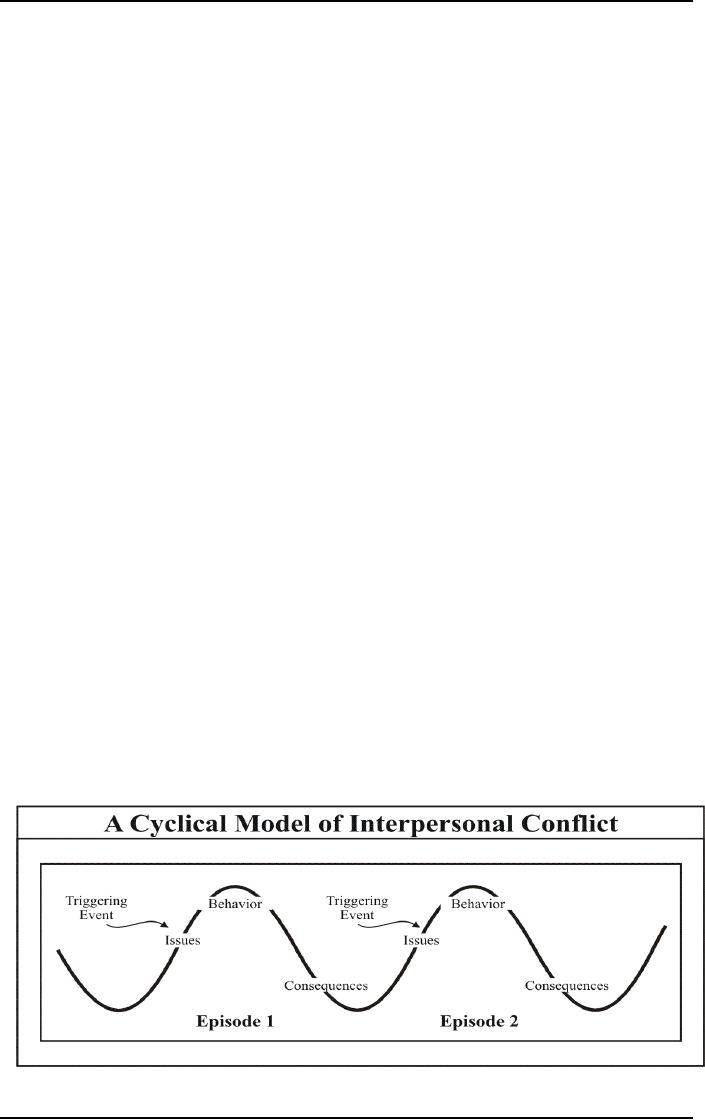 |

Organization
Development MGMT
628
VU
Lesson
30
Interpersonal
and Group Process
Approaches
3.
Third-Party Interventions
Third-party
intervention focuses on conflicts arising
between two or more people
within the same
organization.
Conflict is inherent in groups
and organizations and can
arise from a variety of
sources,
include
differences in personality, task
orientation, and perceptions
among group members, as well
as
competition
for scarce resources. To
emphasize that conflict is
neither good nor bad
per se is important.
Conflict
can enhance motivation and
innovation and lead to
greater understanding of ideas and
views. On
the
other hand, it can prevent
people from working together constructively,
destroying necessary task
interactions
among group members.
Consequently, third-party intervention is
used primarily in situations
in
which
conflict significantly disrupts necessary
task interactions and work relationships
among members.
Third-party
intervention varies considerably
depending on the kind of issues
underlying the conflict.
Conflict
can arise over substantive
issues, such as work
methods, pay rates, and
conditions of employment;
or
it can emerge from interpersonal
issues, such as personalities
and misperceptions. When applied
to
substantive
issues, conflict resolution
interventions often involve resolving
labor-management disputes
through
arbitration and mediation. The
methods used in such
substantive interventions require
considerable
training and expertise in
law and labor relations and
generally are not considered
part of OD
practice.
For example, when union and
management representatives cannot resolve
a joint problem, they
can
call upon the Federal
Mediation and Conciliation
Service to help them resolve the
conflict. In addition,
"alternative
dispute resolution" (ADR)
practices increasingly are
offered in lieu of more
expensive and
time-consuming
court trials. Conflicts also
may arise at the boundaries of the
organization, such as between
suppliers
and the company or between a
company and a public policy
agency.
When
conflict involves interpersonal issues,
however, OD has developed approaches that
help control and
resolve
it. These third-party
interventions help the parties interact
with each other directly,
facilitating their
diagnosis
of the conflict and how to
resolve it. That ability to
facilitate conflict resolution is a basic
skill in
OD
and applies to all of the
process interventions. Consultants,
for example, frequently help
organization
members
resolve interpersonal conflicts that
invariably arise during
process consultation and team
building.
Third-party
consultation interventions cannot resolve
all interpersonal conflicts in organizations,
nor
should
they. Many times, interpersonal conflicts
are not severe or disruptive
enough to warrant attention.
At
other times, they simply may
burn themselves out. Evidence
also suggests that other
methods may be
more
appropriate under certain conditions. For
example, managers tend to
control the process
and
outcomes
of conflict resolution actively when they
are under heavy time pressures, when the
disputants are
not
expected to work together in the future,
and when the resolution of the
dispute has a broad impact
on
the
organization. Under those conditions, the
third party may resolve the
conflict unilaterally with
little
input
from the conflicting
parties.
An
Episodic Model of
Conflict:
Interpersonal
conflict often occurs in iterative,
cyclical stages known as "episodes." An
episodic model is
shown
in Figure 39. At times, issues
underlying a conflict are latent
and do not present any
manifest
problems
for the parties. Then
something triggers the conflict
and brings it into the open.
For example, a
violent
disagreement or frank confrontation
can unleash conflictual
behavior. Because of the
negative
consequences
of that behavior, the unresolved
disagreement usually becomes latent
again. And again,
something
triggers the conflict, making it overt,
and so the cycle continues
with the next conflict
episode.
Figure
39: A cyclical Model of
Interpersonal Conflict

Organization
Development MGMT
628
VU
Conflict
has both costs and benefits
to the antagonists and to those in
contact with them.
Unresolved
conflict
can proliferate and expand.
An interpersonal conflict may be
concealed under a cause or issue
that
serves
to make the conflict appear
more legitimate. Frequently, the overt
conflict is only a symptom of
a
deeper
problem.
The
episode model identifies four
strategies for conflict resolution.
The first three attempts to
control the
conflict
and only the last approach
try to change the basic
issues underlying it. The
first strategy is to
prevent
the ignition of conflict by arriving at a
clear understanding of the triggering
factors and thereafter
avoiding
or blunting them when the symptoms occur.
For example, if conflict
between the research
and
production
managers is always triggered by new
product introductions, then
senior management can
warn
them
that conflict will not be
tolerated during the introduction of the
latest new product. However
this
approach
may not always be functional
and merely may drive the
conflict underground until it
explodes. As
a
control strategy, however, this method
may help to achieve a temporary
cooling-off period.
The
second control strategy is to
set limits on the form of the
conflict. Conflict can be
constrained by
informal
gatherings before a formal meeting or by
exploration of other options. It
also can be limited
by
setting
rules and procedures
specifying the conditions under which the
parties can interact. For
example, a
rule
can be instituted that union
officials can attempt to resolve
grievances with management
only at weekly
grievance
meetings.
The
third control strategy is to
help the parties cope
differently with the consequences of the
conflict. The
third-party
consultant may work with the people
involved to devise coping techniques,
such as reducing
their
dependence on the relationship, ventilating
their feelings to friends, and
developing additional
sources
of
emotional support. These methods
can reduce the costs of the
conflict without resolving the
underlying
issues.
The
fourth method is an attempt to eliminate or to resolve
the basic issues causing the
conflict. As Walton
points
out, "There is little to he
said about this objective because it is the
most obvious and
straightforward,
although it is often the most
difficult to achieve."
Facilitating
the Conflict Resolution
Process:
Walton
has identified a number of factors
and tactical choices that
can facilitate the use of the
episode
model
in resolving the underlying causes of
conflict. The following ingredients
can help third-party
consultants
achieve productive dialogue
between the disputants so that they
examine their differences
and
change
their perceptions and
behaviors: mutual motivation to resolve
the conflict; equality of power
between
the parties; coordinated attempts to
confront the conflict; relevant phasing
of the stages of
identifying
differences and of searching
for integrative solutions; open and clear
forms of communication;
and
productive levels of tension and
stress.
Among
the tactical choices identified by
Walton do those having to do with
diagnosis, the context of the
third-party
intervention, and the role of the
consultant. One of the tactics in
third-party intervention is the
gathering
of data, usually through
preliminary interviewing. Group-process
observations can also be
used.
Data
gathering provides some understanding of the nature
and the type of conflict, the personality
and
conflict
styles of the individuals involved, the
issues and attendant pressures,
and the participants' readiness
to
work together to resolve the
conflict.
The
context in which the intervention
occurs is also important. Consideration
of the neutrality of the
meeting
area, the formality of the setting, the
appropriateness of the time for the
meeting (that is, a
meeting
should
not be started until a time
has been agreed on to
conclude or adjourn), and the careful
selection of
those
who should attend the meeting are
all elements of this context.
In
addition, the third-party consultant must
decide on an appropriate role to assume
in resolving conflict.
The
specific tactic chosen will
depend on the diagnosis of the situation.
For example, facilitating
dialogue
of
interpersonal issues might include
initiating the agenda for the
meeting, acting as a referee
during the
meeting,
reflecting and restating the issues
and the differing perceptions of the
individuals involved,
giving
feedback
and receiving comments on the
feedback, helping the individuals
diagnose the issues in
the
conflict,
providing suggestions or recommendations,
and helping the parties do a better
job of diagnosing
the
underlying problem.
The
third-party consultant must develop
considerable skill at diagnosis,
intervention, and follow-up.
The
third-party
intervener must be highly sensitive to
his or her own feelings
and to those of others. He or
she
also
must recognize that some
tension and conflict are
inevitable and that although
there can be an
optimum
amount and degree of conflict,
too much conflict can be
dysfunctional for both the people
involved
and the larger organization. The
third-party consultant must be sensitive
to the situation and
able
to
use a number of different intervention
strategies and tactics when
intervention appears to be
useful.
Finally,
she or he must have
professional expertise in third-party
intervention and must be
seen by the
parties
as neutral or unbiased regarding the
issues and outcomes of the
conflict resolution.
Application
6 describes an attempt to address
conflict in an information technology
unit. How does this

Organization
Development MGMT
628
VU
description
fit with the process
described above? What would
you have done
differently?
Application
6: Conflict Management at Balt Healthcare
Corporation
Pete
and Dan were managers in an
IT department that was part of the
information services group at
Bait
Healthcare
Corporation, a large organization that
provided health-care products to a global
market. Pete
was
the general manager of the IT department
and had been working in the
unit for most of his 16
years
with
Bait. The IT department had global responsibility
for developing and maintaining the
organization's
intranets,
Websites, and internal networks.
Pete ran his department with
a traditional and
formal
management
style where communication traveled vertically
through the hierarchy.
Dan
recently had been assigned
to Pete's department to operate a small
experimental group charged
with
developing
e-commerce solutions for the organization
and the industry. This was
state-of-the-art
development
work with enormous future
implications for the organization as it explored the
possibility of
sales,
business-to-business and other supply
chain opportunities on the Internet.
Dan, in contrast to
Pete,
had
a management style that
stressed the value of open communication
channels to promote teamwork
and
collaboration.
The
biggest challenge in Dan's
work was managing the
transition from design into
production. Senior
management
at Bait believed that by assigning
Dan's team to Pete's organization, the
resources required to
manage
this transition would be more readily
available to Dan's group. In fact, it
was generally agreed
that
Pete's
strengths complimented Dan's weaknesses.
Whereas Dan was a better
designer, Pete had
operational
expertise
that would help in bringing
Dan's ideas online.
Unfortunately,
the trouble started almost as
soon as the assignment was
announced. Although in front
of
their
bosses Pete had agreed to
work with Dan to make the
project a success, his
support was lukewarm at
best.
Dan and Pete had a
history of conflict in the organization.
Neither one respected the other's
style, and
prior
conflicts had been swept under the
carpet, creating a considerable amount of
pent-up animosity.
Operationally,
when Dan's group needed
resources to bring an idea
online, Pete announced that
all of his
people
were busy and that he
couldn't assign anyone to help.
Similarly, anytime Dan needed
access to a
piece
of hardware within the IT unit.
Pete made it complicated to
get that access. Dan
became increasingly
frustrated
by Pete's lack of cooperation and he
was quite open about his
feelings of being sabotaged.
His
complaints
reached the highest levels of
management as well as other
members of the information
services
staff.
After
several frustrating attempts to
speak with Pete about the
situation, Dan consulted Marilyn, the
vice
president
for information services.
Marilyn, like others in the organization,
was aware of the conflict.
She
requested
assistance from the human
resources manager and an organization
development specialist. The
OD
specialist met with Pete
and Dan separately to
understand the history of the conflict
and each
individuals
contribution to it. Although
different styles were partly
to blame, the differences in the
two
work
processes were also
contributing to the problem. Pete's organization
was primarily routine
development
and maintenance tasks that
allowed for considerable preplanning
and scheduling of
resources.
Dan's
project, however, was highly creative
and unpredictable. There was little
opportunity to give Pete
advance
notice regarding the experimental team's
needs for equipment and
other resources.
The
OD specialist recommended several
strategies to Marilyn, including a direct
confrontation, the
purchase
of additional hardware and
software, and mandating the antagonists'
cooperation. Marilyn
responded
that there was no available
budget for purchasing new equipment
and admitted that she did
not
have
any confidence in her ability to
facilitate the needed communication and
leadership for her staff.
She
asked
the OD specialist to facilitate a more direct
process. Agreements were
made in writing about how
the
process
would work, including
Marilyn meeting with Dan
and Pete to discuss the
problem between them
and
how it was affecting the organization.
But Marilyn did not
follow through on the agreement.
She never
met
with Pete and Dan at the
same time and, as a result, the
messages she sent to each
were inconsistent.
In
fact, during their separate
conversations, it appeared that
Marilyn began supporting
Pete and began
criticizing
Dan. Dan began to withdraw,
productivity in both groups
suffered, and he became more
hostile,
stubborn,
and bitter.
In
the end, Dan felt sabotaged
not only by Pete but by
Marilyn as well. He took a leave of
absence based
on
Marilyn's advice. His
project was left without a
leader and he ended up leaving the
organization. Pete
stayed
on, but staff at all levels
of the organization were upset that
his behavior had not
been questioned.
Similarly,
the organization lost a lot of respect
for Marilyn's ability to
address conflict. Losses
in
productivity
and morale among staff in
many areas in the organization resulted
from the conflict
between
two
employees.
Table of Contents:
- The Challenge for Organizations:The Growth and Relevance of OD
- OD: A Unique Change Strategy:OD consultants utilize a behavioral science base
- What an “ideal” effective, healthy organization would look like?:
- The Evolution of OD:Laboratory Training, Likert Scale, Scoring and analysis,
- The Evolution of OD:Participative Management, Quality of Work Life, Strategic Change
- The Organization Culture:Adjustment to Cultural Norms, Psychological Contracts
- The Nature of Planned Change:Lewin’s Change Model, Case Example: British Airways
- Action Research Model:Termination of the OD Effort, Phases not Steps
- General Model of Planned Change:Entering and Contracting, Magnitude of Change
- The Organization Development Practitioner:External and Internal Practitioners
- Creating a Climate for Change:The Stabilizer Style, The Analyzer Style
- OD Practitioner Skills and Activities:Consultant’s Abilities, Marginality
- Professional Values:Professional Ethics, Ethical Dilemmas, Technical Ineptness
- Entering and Contracting:Clarifying the Organizational Issue, Selecting an OD Practitioner
- Diagnosing Organizations:The Process, The Performance Gap, The Interview Data
- Organization as Open Systems:Equifinality, Diagnosing Organizational Systems
- Diagnosing Organizations:Outputs, Alignment, Analysis
- Diagnosing Groups and Jobs:Design Components, Outputs
- Diagnosing Groups and Jobs:Design Components, Fits
- Collecting and Analyzing Diagnostic information:Methods for Collecting Data, Observations
- Collecting and Analyzing Diagnostic information:Sampling, The Analysis of Data
- Designing Interventions:Readiness for Change, Techno-structural Interventions
- Leading and Managing Change:Motivating Change, The Life Cycle of Resistance to Change
- Leading and managing change:Describing the Core Ideology, Commitment Planning
- Evaluating and Institutionalizing Organization Development Interventions:Measurement
- Evaluating and Institutionalizing Organization Development Interventions:Research Design
- Evaluating and Institutionalizing Organization Development Interventions
- Interpersonal and Group Process Approaches:Group Process
- Interpersonal and Group Process Approaches:Leadership and Authority, Group Interventions
- Interpersonal and Group Process Approaches:Third-Party Interventions
- Interpersonal and Group Process Approaches:Team Building, Team Building Process
- Interpersonal and Group Process Approaches:Team Management Styles
- Organization Process Approaches:Application Stages, Microcosm Groups
- Restructuring Organizations:Structural Design, Process-Based Structures
- Restructuring Organizations:Downsizing, Application Stages, Reengineering
- Employee Involvement:Parallel Structures, Multiple-level committees
- Employee Involvement:Quality Circles, Total Quality Management
- Work Design:The Engineering Approach, Individual Differences, Vertical Loading
- Performance Management:Goal Setting, Management by Objectives, Criticism of MBO
- Developing and Assisting Members:Career Stages, Career Planning, Job Pathing
- Developing and Assisting Members:Culture and Values, Employee Assistance Programs
- Organization and Environment Relationships:Environmental Dimensions, Administrative Responses
- Organization Transformation:Sharing the Vision, Three kinds of Interventions
- The Behavioral Approach:The Deep Assumptions Approach
- Seven Practices of Successful Organizations:Training, Sharing Information